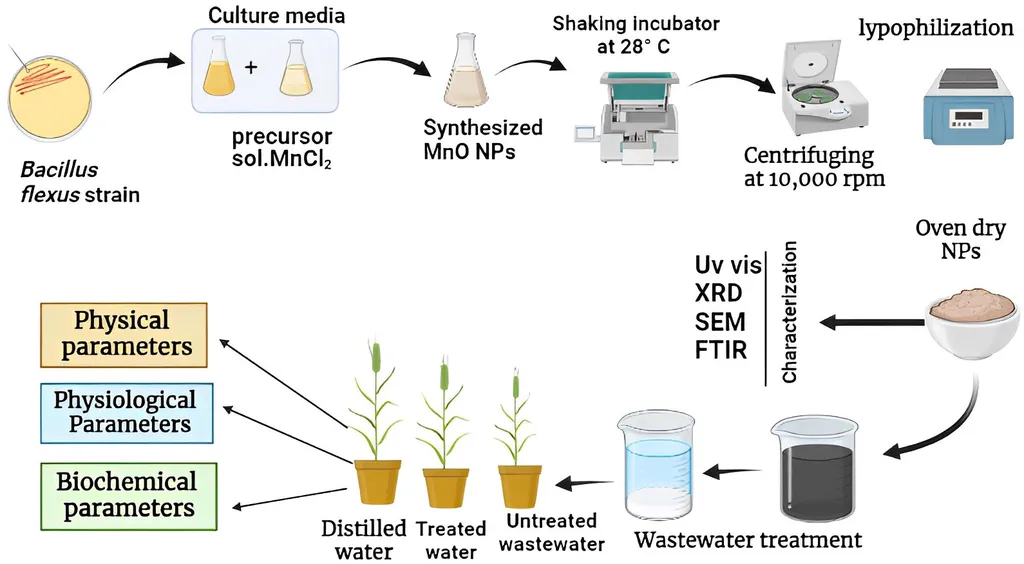In the quest for sustainable and efficient wastewater treatment solutions, a groundbreaking study has emerged from the Department of Food, Nutrition & Agricultural Sciences at Grand Asian University Sialkot, Pakistan. Led by Khadija Siddique, the research delves into the comparative efficacy of biologically and chemically synthesized nickel oxide nanoparticles (NiO-NPs) for catalytic degradation of dyes and wastewater treatment. Published in the esteemed journal *Scientific Reports* (translated to English as “Scientific Reports”), this study could potentially reshape the landscape of industrial wastewater management and energy sector applications.
The study focuses on the synthesis of NiO-NPs using both chemical and biological methods, with a particular emphasis on their photocatalytic activity. The researchers characterized the nanoparticles using various techniques, including X-ray diffraction, X-ray photoelectron spectroscopy, scanning electron microscopy, Fourier-transform infrared spectroscopy, and zeta potential analysis. The results were striking: biosynthesized NiO-NPs outperformed their chemically synthesized counterparts in degrading organic pollutants.
“Biosynthesized NiO-NPs exhibited higher photocatalytic activity and faster degradation rates,” Siddique noted. The biosynthesized nanoparticles decolorized methylene blue (MB) dye by an impressive 90% in just one minute, while chemically synthesized NPs required five minutes to achieve similar results. This efficiency extended to other pollutants as well; biosynthesized NiO-NPs degraded 4-nitrophenol (4-NP) more efficiently, achieving 65% decolorization in 25 minutes.
The study’s implications for the energy sector are profound. Photocatalysis, the process by which light energy is used to drive chemical reactions, is a promising avenue for sustainable energy solutions. Efficient photocatalysts like the biosynthesized NiO-NPs could revolutionize wastewater treatment in industrial settings, reducing the environmental impact of textile and other dye-intensive industries.
“These findings suggest that biogenic NiO-NPs are highly efficient photocatalysts for organic pollutant degradation,” Siddique explained. The study demonstrated the potential of these nanoparticles in degrading a variety of azo dyes, including reactive red-120, reactive black-5, brilliant yellow, and brilliant blue-R. In dye-loaded textile wastewater, the biosynthesized NiO-NPs decolorized 84.8% of added reactive black-5 and 70.3% of added reactive red-120, outperforming their chemically synthesized counterparts.
The commercial impacts of this research are significant. As industries strive to meet increasingly stringent environmental regulations, the demand for efficient and sustainable wastewater treatment solutions is on the rise. Biosynthesized NiO-NPs offer a promising alternative to conventional chemical methods, potentially reducing costs and environmental impact.
“This research opens up new possibilities for the application of biogenic nanoparticles in industrial wastewater treatment,” Siddique said. The study’s findings could pave the way for further research and development in the field of photocatalysis, ultimately contributing to a more sustainable and energy-efficient future.
As the world grapples with the challenges of environmental pollution and climate change, innovative solutions like those presented in this study are more important than ever. The research led by Khadija Siddique and her team at Grand Asian University Sialkot offers a glimpse into the future of wastewater treatment and the potential of biogenic nanoparticles to drive sustainable development in the energy sector. With the publication of this study in *Scientific Reports*, the scientific community is one step closer to unlocking the full potential of these remarkable nanoparticles.

